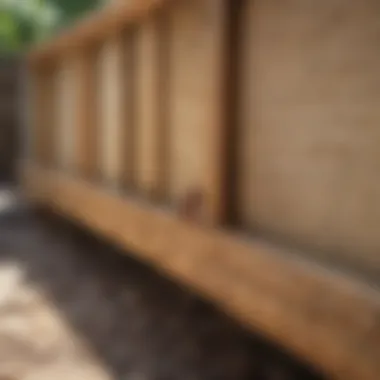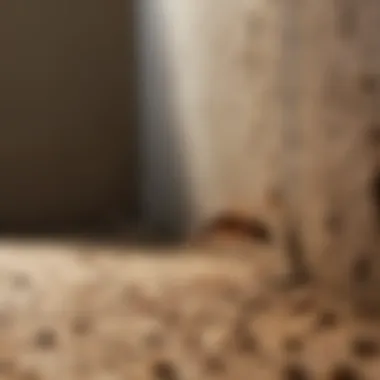Effective Strategies for Removing Termites Around Your Home


Preventive Pest Control Strategies
Termites can wreak havoc on your property if left unaddressed, making preventive pest control strategies imperative. Protecting your home from these destructive pests requires a multi-faceted approach that begins with safeguarding the exterior of your house. Sealing cracks and crevices is essential to thwart termite entry points, while clearing debris in your yard eliminates harborage spots. Moreover, implementing measures to deter pests from entering your home is crucial in establishing a barrier against termite infestations. These small steps fortify your home against termite invasions.
When it comes to yard maintenance, following essential routines is key to keeping your outdoor area pest-free. Regular upkeep, such as mowing the lawn and removing standing water, can prevent termite breeding grounds. Additionally, maintaining an immaculate indoor environment is pivotal in deterring termites from making themselves at home. Expert cleaning tips and techniques aid in eliminating potential hiding spots for pests, ensuring a pest-resistant indoor setting.
Proper garbage disposal practices play a significant role in pest prevention. Efficient waste management methods not only discourage termite activity but also contribute to a cleaner environment. Beyond standard practices, exploring innovative ways to safeguard your home, such as utilizing natural repellents and environmentally-friendly solutions, enhances the efficacy of your pest control efforts.
Identifying Pest Risk Areas
To effectively combat termite infestations, identifying potential risk areas is paramount. Inspecting moisture-prone areas for damp conditions is crucial as termites thrive in moist environments. By identifying and rectifying these conditions, you can mitigate the risk of infestations. Furthermore, conducting crack and crevice inspections aids in sealing potential access points that termites exploit. Keeping greenery in check is also essential as overgrown vegetation can attract pests, including termites, to your yard.
Expert pest control goes beyond traditional methods. Utilizing natural repellents, such as essential oils and herbal solutions, provides a safe yet effective approach to controlling pests. Similarly, employing chemical sprays under professional guidance can eradicate pests effectively. Pest traps serve as another valuable tool in pest control, allowing for the capture and removal of pests with minimal harm to the environment.
Biological control methods, which involve using natural predators to manage pests, offer an environmentally-friendly alternative to chemical interventions. These methods not only target specific pests but also help maintain ecological balance. Exploring innovative pest control methods ensures a comprehensive approach to termite eradication beyond conventional techniques.
Pest Species Identification
Understanding the pests that pose a risk to your home is crucial in implementing effective control measures. Common insects like ants, cockroaches, and spiders can be managed through proper identification and targeted treatments. Similarly, being able to identify rodent species, such as mice and rats, aids in preventing infestations through suitable prevention strategies.
Bird species can also impact home environments, with certain birds causing damage to property and posing health risks. By addressing bird-related issues promptly, you can protect your home from potential threats. Furthermore, handling encounters with wildlife requires specific measures to ensure both your safety and that of the animals. Recognizing and managing lesser-known pests effectively rounds out your pest species identification knowledge, enabling you to tackle a broader range of pest threats.
DIY Pest Control Techniques
For those inclined towards a hands-on approach, do-it-yourself (DIY) pest control techniques offer a more involved way to address termite infestations. Homemade pest control solutions provide eco-friendly alternatives to chemical treatments, safeguarding your home while minimizing environmental impact. Incorporating essential oils into your pest control repertoire allows for the natural repulsion of pests, creating a bug-free living environment.
Implementing effective pest traps and barriers around your property assists in controlling and preventing infestations before they escalate. Choosing reputable pest control brands ensures the quality and efficacy of the products you use, offering peace of mind in your pest management efforts. Exploring miscellaneous DIY pest control techniques caters to a spectrum of pest issues, empowering homeowners with diverse solutions to combat termite attacks.
Understanding Termites
Termites are a type of insect known for their destructive behavior, causing damage to properties, especially wooden structures. In this article, understanding termites is crucial as it lays the foundation for effectively combating infestations outside your home. By delving into the types of termites and their behaviors, homeowners can proactively safeguard their homes against potential damage.
Types of Termites


Subterranean Termites
Subterranean termites are known for building their colonies underground. They construct elaborate tunnel systems to access food sources, primarily cellulose-based materials like wood. This makes them a prevalent threat to homes, as they can remain hidden while causing significant damage. Understanding the behaviors and characteristics of subterranean termites is essential for targeted eradication methods.
Drywood Termites
Drywood termites, in contrast to subterranean termites, do not require contact with soil to thrive. They infest dry wood structures within homes, making them a notable concern for homeowners. Their ability to survive solely on wooden materials highlights the importance of identifying and addressing drywood termite infestations promptly.
Dampwood Termites
Dampwood termites prefer moist wood and do not typically infest dry structures. Their presence indicates potential moisture issues in and around a property. While not as common as other termite species, dampwood termites can still pose a threat to vulnerable wood components. Recognizing the unique characteristics of dampwood termites is key to implementing targeted control measures.
Each type of termite presents distinct challenges and requires tailored solutions to effectively eliminate them from the external areas of a home.
Termite Behavior
Feeding Habits
Termites feed on cellulose material present in wood and other plant-based products. Their insatiable appetite for cellulose makes them a constant threat to wooden structures. Understanding the feeding habits of termites is crucial for implementing preventive measures and choosing appropriate treatment strategies.
Nesting Patterns
Termites establish intricate nests within wood structures or underground, creating centralized hubs for their colonies. These nesting patterns allow termites to live and reproduce effectively, leading to rapid population growth. By grasping the nesting behavior of termites, homeowners can target these vulnerable areas to disrupt termite colonies.
Signs of Infestation
Detecting signs of termite infestation early can prevent extensive damage to a property. Common indicators include mud tubes, hollow-sounding wood, discarded wings, and frass residue. Being vigilant about these signs can help homeowners take prompt action against termites, preserving the integrity of their homes.
Understanding termites' behavior patterns equips homeowners with valuable insights to combat infestations proactively and protect their properties from termite-induced damage.
Inspection and Identification
In the context of effective termite control, Inspection and Identification play a pivotal role in safeguarding properties from these destructive pests. This section focuses on the crucial steps involved in detecting and assessing termite infestations, allowing homeowners to take proactive measures in protecting their homes.
Property Inspection


- Exterior Assessment: Conducting a thorough Exterior Assessment is a foundational aspect of termite control. By inspecting the exterior of a property, individuals can identify potential entry points and vulnerable areas that may attract termites. This step is essential in understanding the scope of the infestation and devising appropriate treatment strategies. The key characteristic of Exterior Assessment lies in its ability to provide a comprehensive overview of the property's susceptibility to termite infiltration. While time-consuming, this method is highly effective in identifying early signs of termite presence, enabling prompt action to be taken.
- Interior Examination: Delving into Interior Examination allows for a deeper insight into the extent of termite activity within a property. By investigating areas inside the home where termites are likely to inhabit, such as basements, attics, and crawl spaces, individuals can pinpoint active infestation sites and assess the level of damage caused. The key characteristic of Interior Examination is its ability to reveal hidden infestations that may not be visible during exterior inspections. However, this method requires thoroughness and attention to detail to ensure all affected areas are properly identified.
- Identifying Entry Points: Recognizing and addressing Entry Points is critical in preventing future termite intrusions. By sealing off entry points such as cracks, crevices, and gaps in the foundation or walls, homeowners can effectively fortify their property against termite attacks. The unique feature of Identifying Entry Points lies in its proactive approach to termite control, as it focuses on minimizing the risk of infestations through physical barriers. While this method may require ongoing maintenance, its advantages include long-term protection against termite incursions.
Termite Identification
- Recognizing Termite Species: Distinguishing between different termite species is essential for implementing targeted control measures. Each termite species has varying behavior patterns and response to treatments, making accurate identification crucial for effective extermination. The key characteristic of Recognizing Termite Species lies in its ability to tailor treatment strategies to the specific species infesting the property. While this process may require professional assistance in some cases, it enhances the efficacy of termite control efforts.
- Damage Assessment: Evaluating the extent of damage caused by termites is integral to understanding the severity of an infestation. Damage Assessment involves inspecting wooden structures for signs of decay, hollowing, or mud tubes created by termites. The key characteristic of Damage Assessment is its role in estimating the level of structural compromise and guiding repair efforts post-extermination. While the visual inspection may reveal surface-level damage, thorough assessment by professionals can uncover hidden structural issues caused by termites.
- Seeking Professional Help: Engaging professional pest control services is a prudent step in addressing complex termite infestations. Pest control experts possess the expertise and resources to conduct thorough inspections, recommend tailored treatment plans, and execute effective extermination strategies. The unique feature of Seeking Professional Help is the access to advanced technologies and industry knowledge that can expedite the termite eradication process. While professional assistance may incur additional costs, the benefits include comprehensive termite management and long-term protection against future infestations.
Natural Termite Control Methods
In the battle against termite infestations around your home, understanding and utilizing natural termite control methods can be a game-changer. These methods offer an eco-friendly and safe approach to tackle termites without harming the environment or your family. In this section, we delve into the essential aspects of natural termite control methods, shedding light on their significance and benefits in safeguarding your property against these insidious pests.
Beneficial Nematodes
Introduction to Nematodes
Beneficial nematodes are microscopic roundworms that act as natural predators to termites. Their introduction into the soil surrounding your home can aid in controlling termite populations effectively. These nematodes seek out termites as hosts, ultimately leading to the elimination of termite colonies. Their ability to target and feed on termites makes them a popular choice for those seeking a non-toxic approach to termite eradication. Despite their small size, beneficial nematodes play a crucial role in maintaining a healthy termite balance within your property. While they offer a sustainable and chemical-free solution, it is essential to consider that their effectiveness may vary depending on the type and size of termite infestation.
Application Techniques
To utilize beneficial nematodes effectively, proper application techniques are vital. These nematodes are typically applied to the soil around the perimeter of your home or directly into termite colonies. The application can involve mixing nematodes with water and using a sprayer for even distribution. By ensuring thorough coverage of the target area, you can enhance the success rate of nematode treatment. Additionally, following application guidelines and considering environmental factors such as temperature and moisture levels can contribute to the longevity and efficiency of beneficial nematodes in controlling termite populations.
Effectiveness Against Termites
The effectiveness of beneficial nematodes in combating termites stems from their ability to seek out and parasitize termite larvae and workers. As these nematodes multiply and infiltrate termite colonies, they serve as a natural predator, ultimately leading to the decline of termite populations. The targeted nature of this method makes it a valuable asset in managing termite infestations without resorting to chemical treatments. While beneficial nematodes demonstrate effectiveness in reducing termite numbers, it is important to note that their impact may be gradual, requiring consistent application and monitoring to ensure long-term control.
Chemical Treatment Options
Chemical treatment options play a crucial role in the overall strategy outlined in this comprehensive guide on effective termite elimination outside your home. By employing chemical treatments, homeowners can target termites effectively with proven solutions. These treatments often provide a reliable way to combat termite infestations, offering a systematic approach to managing and eradicating these destructive pests. Understanding the specific elements, benefits, and considerations of chemical treatment options is paramount in safeguarding your property.
Liquid Termiticides
Liquid termiticides are an integral part of chemical treatment options, known for their efficacy in targeting termites. The application methods for liquid termiticides are diverse, ranging from trenching and rodding to soil injections. These methods allow for precise application around the perimeter of the property, creating a barrier against termite entry. The key characteristic of liquid termiticides lies in their ability to create a long-lasting defense against termites, making them a popular choice among homeowners seeking reliable termite control solutions.
Application Methods
Liquid termiticides offer flexibility in application, allowing for customized treatment based on the extent of infestation. Professional application ensures thorough coverage of the affected areas, utilizing specialized equipment for precise delivery. DIY treatments, although accessible, may lack the expertise and equipment required for comprehensive protection. However, DIY treatments can be cost-effective for smaller infestations.


Professional vs. DIY Treatment
Professional application of liquid termiticides is recommended for extensive infestations or recurring termite problems. Professionals possess the knowledge and experience to effectively treat termite colonies, ensuring long-term protection. DIY treatments, while suitable for minor infestations, may not provide the same level of coverage and expertise. Homeowners must weigh the advantages and disadvantages of both approaches before deciding on the appropriate treatment option.
Long-Term Effectiveness
The long-term effectiveness of liquid termiticides is a significant factor to consider when implementing termite control measures. These treatments form a durable barrier that persists in the soil, deterring termites from returning. Regular inspections and maintenance can enhance the longevity of liquid termiticides, ensuring continuous protection against termite threats. Understanding the advantages and disadvantages of this long-term approach can help homeowners make informed decisions regarding their termite control strategies.
Termite Baits
Termite baits offer an alternative approach to chemical treatment options, utilizing bait stations to attract and eliminate termite colonies. Understanding how baits work, the placement strategies, and the importance of monitoring and maintenance is key to the successful implementation of this control method
How Baits Work
Termite baits work by luring termites to stations containing toxic substances. Worker termites feed on the bait and carry it back to the colony, effectively eradicating the entire population. The gradual spread of the bait ensures comprehensive termite elimination while minimizing environmental impact. This method is favored for its targeted approach and reduced chemical usage.
Placement Strategies
Strategic placement of bait stations is essential for maximizing their effectiveness. Stations should be positioned around the perimeter of the property and near known termite activity sites. Placing baits in areas with high termite traffic increases the likelihood of successful bait consumption, accelerating colony eradication. The careful selection of placement sites is a critical aspect of implementing termite baits.
Monitoring and Maintenance
Regular monitoring and maintenance of termite bait stations are vital for ensuring continuous protection against termite infestations. Inspection intervals allow homeowners to assess bait consumption levels and identify any resurgence in termite activity promptly. Refilling and replacing baits as needed maintains the effectiveness of the stations and sustains ongoing termite control efforts. By prioritizing monitoring and maintenance, homeowners can proactively manage termite threats outside their homes.
Preventive Measures
Preventive measures play a pivotal role in safeguarding your home against the destructive nature of termites. It is essential to be proactive in addressing potential vulnerabilities that termites may exploit to access your property. By focusing on preventive measures, you can significantly reduce the risk of termite infestations and protect your home in the long term. Taking into account factors such as moisture control and wood treatment can go a long way in fortifying your home's defenses against these relentless pests.
Moisture Control
Repairing Leaks
Repairing leaks is a crucial aspect of moisture control when it comes to termite prevention. Leaks can create damp environments that attract termites, providing them with the perfect conditions to thrive. By promptly addressing and fixing any leaks in your home, you not only reduce moisture levels but also eliminate potential entry points for termites. The key characteristic of repairing leaks lies in its ability to mitigate the risk of termite infestations by removing one of the primary factors that attract these pests. While repairing leaks may require initial investment, the long-term benefits of preserving your home's structural integrity and preventing termite damage far outweigh the costs.
Proper Drainage
Proper drainage is another essential component of moisture control in termite prevention strategies. Ensuring that water is effectively directed away from your home prevents excess moisture buildup around the foundation, which can lure termites towards your property. The key characteristic of proper drainage lies in its capacity to channel water away from vulnerable areas, minimizing the chances of termite infestations. Implementing proper drainage systems not only deters termites but also enhances the overall resilience of your home against water-related issues. While setting up adequate drainage may require initial planning and investment, the long-term advantages of protecting your home from termite damage make it a worthwhile endeavor.
Ventilation Systems
Integrating effective ventilation systems is a critical aspect of moisture control and termite prevention. Proper ventilation helps regulate humidity levels within your home, reducing the risk of excessive moisture accumulation that could attract termites. The key characteristic of ventilation systems lies in their ability to maintain airflow and prevent damp conditions that facilitate termite activity. By improving air circulation and reducing humidity, ventilation systems contribute significantly to creating an inhospitable environment for termites. While installing ventilation systems may involve some upfront costs, the long-term benefits of preserving your home's integrity and deterring termites make it a valuable investment.



